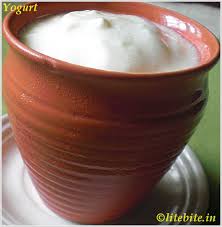Hello friend,here v find some facts about
Curd Vs. Yogurt: What's the Difference Anyway?
Curd/dahiDahi is made by boiling and cooling the milk to 30-40°C and adding a spoonful of curd. Now curd has lactic acid bacteria or lactobacillus. This bacteria multiplies itself in the ambient temperature of 30-40°C and in few hours ferments the milk to form curd. Curd is a rich source of calcium and protein and is suitable for lactose intolerant people (though it depends on the degree of tolerance).
In India, curd is regarded as very good for stomach as it aids digestion and gives a cooling relief from spicy foods. But because curd and its bacterial strength vary from one home to the other, it is not a standardised product. So the good bacteria present in curd may or may not reach the intestines alive to give the expected health benefits.
YogurtYogurt is prepared using similar techniques to curd but the fermentation of the milk is done by adding two specific strains of bacteria called lactobacillus bulgaris and streptococcus thermophilus. Other strains of lactic acid bacteria may also be added. The addition of these bacteria makes the product standardised and homogenous. This ensures both quality and right quantity of bacteria in the yogurt. Also, more of the good bacteria reach the intestines alive.
Probiotic yogurt
Probiotics are live microorganisms that provide health benefits to the consumer when given in specific quantities. For any product to be called a probiotic (such as a yogurt or drink) the product must contain a specific strain of live bacteria that is resistant to gastric acid, bile and pancreatic juices, and which reaches the intestines alive to give the correct health benefit.
No comments:
Post a Comment